
me sewing outside
I have been involved in sewing for some time now.
I practice cutting fabrics, finding out the right proportions for my body size and a lot of trial and error. What have I learned?
That the human hand is a very complex and fascinating structure. A hand can do many things that a machine cannot. There is hardly anything in the world that can match the dexterity of human fingers when processing material.
Let's take a sewing machine and compare.
A sewing machine, before it is assembled and able to sew, requires countless parts. It has a multitude of screws, springs, gears, threads, pistons and so on. When you look at the inside of such a machine, you are amazed at how much material, metal and plastic is needed to perform just one function: To sew straight. Many inventive hours had to pass before the thread reaches the necessary tension, which a human hand can manage by merely trying it out once. To develop such a thing, a creative and certainly very satisfying job: for the developer.
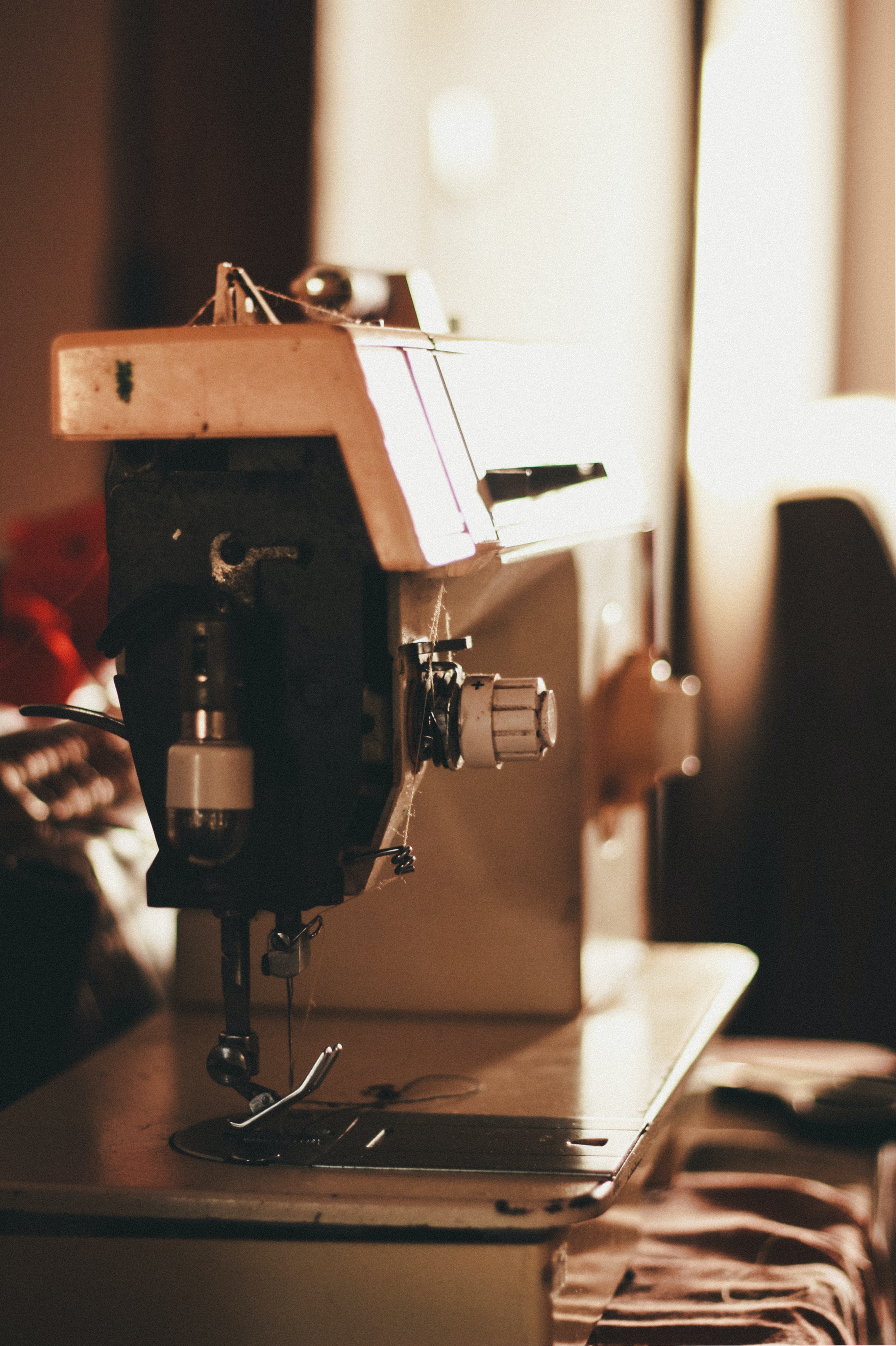
Photo by Júnior Ferreira on Unsplash
Nevertheless, for a home sewing machine only capable of sewing straight ahead, I wondered if it was worth the effort to produce such a complex machine, only rudimentarily able to copy human finger dexterity, but still reduced to its machine function of sewing.
Whereas the human hand, as far as it has finished sewing, is capable of much more. It can also handle knives, pots, pans, balls, hammers, saws, hatchets, arrows and bows, combs, scissors, brushes, planes, screwdrivers, eyes, frames and much more. For all these wonderful abilities of our human hands, a very elaborately manufactured machine is needed in each case, which can only do one particular thing at a time.
The seemingly simple process of just one movement of the hand, the up and down of the needle, which is held by two fingers and then pulled through the fabric held by the second hand, requires an immense amount of technology and apparatus on the machine side. Basically ridiculous, to procure, shape, harden, assemble so much metal and material in the first place, just to be able to copy this graceful work. So at this moment one can ask the question, what is the point?
When it comes to clothes, the least of all jobs is the one with the machine at the home table.
It takes much more time and effort to cut the fabric, to prepare it for sewing in such a way that at some point, when the maths is done, it can be assembled into a fitting garment. Sewing straight lines is basically hardly worth mentioning and if you subtract the level of engagement and effort it takes to learn how to use the machine in the first place, the time saved is actually rather inglorious.
In the second step, one can ask oneself: What is the point of saving time for sewing straight sections when the human body is no more than two metres? Sewing two metres of web by hand is no problem at all. In fact, it is only when you have longer distances to sew that a certain sewing rhythm sets in. It is this distance that makes a certain rhythm and uniformity possible.
The monotony of such work is extremely calming and meditative. It brings about a calm mind and a steady hand.
How much trouble in comparison I have experienced with my machine when the thread tension is not correct, when the thread and fabric do not match and I do not notice this because it is not my fingers that feel the fabric and its behaviour, but the machine produces faulty seams, when the machine sewing foot does not cooperate, when the thread eats into the fabric and the machine, when I cannot get to certain places at all well, where corners, curves and difficult edges are involved. When the bottom doesn't make the top visible and I have to keep raising and lowering the presser foot to check that the fabric underneath isn't being sewn along by mistake. And so on. Then there are the problems with the machine itself, which doesn't work well if I don't handle it correctly.
Over time, without realising it, you adapt to the needs of the machine and not the other way around. A machine can never adapt to human needs in the way he needs, it has clear limitations.
Sewing clothes for your own use is very satisfying. Sewing them by hand is even more satisfying.
There is no shame in using a machine, certainly not, but you can also do without it. Doing without leads to certain realisations. It may take a little longer to sew everything by hand once you are more professional with the sewing machine, but for your own use it is not really necessary.
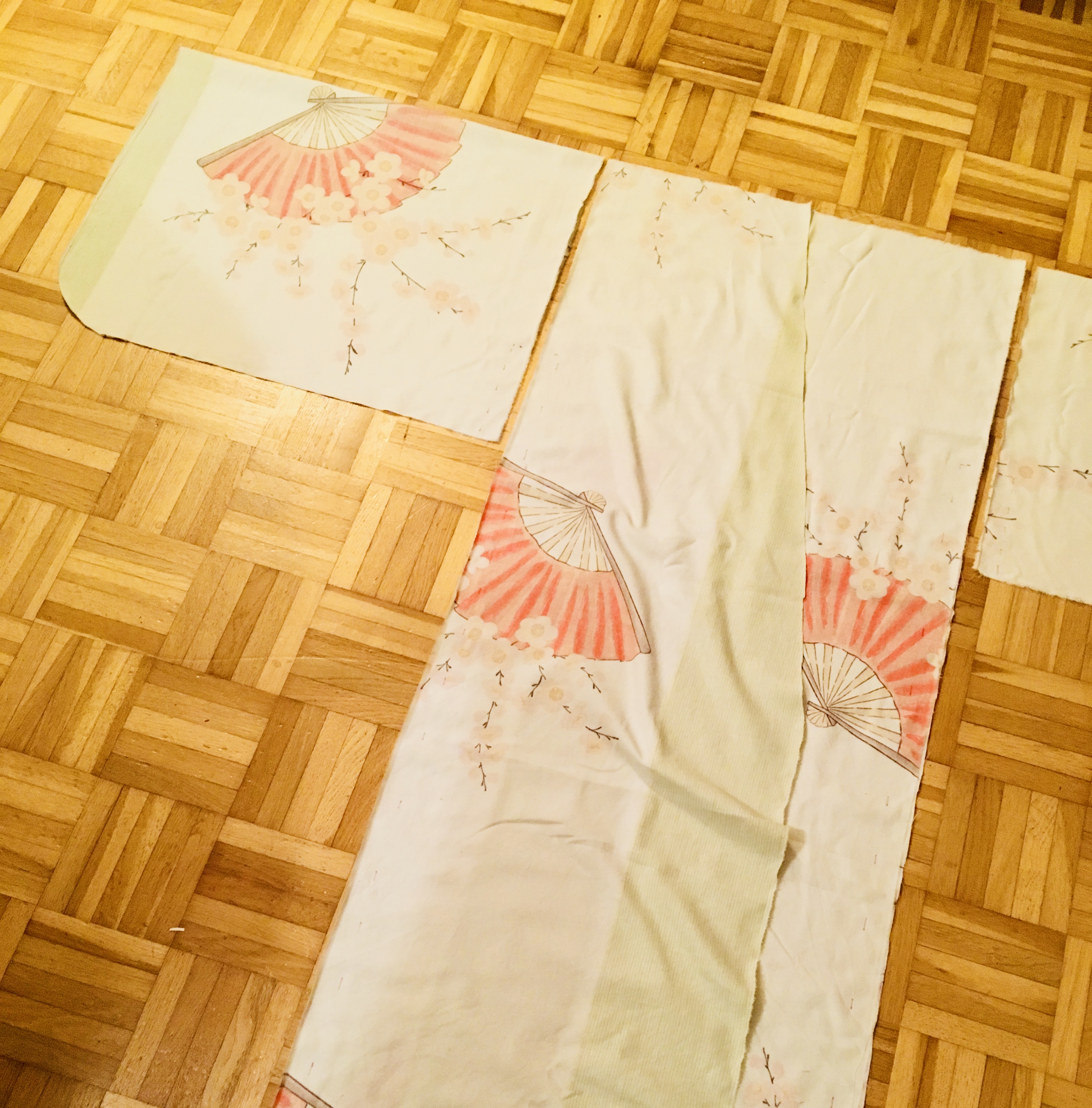
I cut this out of old bed sheets into a kimono
The myth that sewing machine seams are stronger or last better is just a myth.
Hand-sewn seams - if done properly - are just as strong and tear-resistant as machine seams. But probably the biggest advantage is that you can trick the fabric. A machine can only sew the upper and the lower fabric together.
But in order not to do that and nevertheless create a holding together seam the human hand can stitch in between. The hand can twist the fabric into angles a machine cannot perform. Or, if so, is manufactured particularly for this single action.
My point is, how many different machines does one need in order to perform the actions a human hand can do just by being as it is? Where I am getting at is the fact that learning things first doing by hand, is actually the step for developers to create something which can copy that skill.
There will be a moment, when you will become bored
with different machines for different tasks, all replacing your handy works and where you will be busy with machine-maintenance, cracking your head over technical issues, investing money into replacing-parts, talking to others how to make them run again and so and and so forth.
It might be worth the time to come into social human contact but it won't serve you in order to become more independent from machines.
Once everything is done for you by machines, there will be nothing left to be truly creative and inventive on your own side. Having different types of machines for sewing purposes in the house, like a straight stitching machine, an overlocker, an embroidery-machine etc. leaves you unskilled when it comes to real handy work.
So I realized that the truly fun part in sewing is those works which last a certain amount of time, need my attention and concentration, need my skillful spontaneity in order to solve occurring problems, want my creativity to be challenged and my mistakes to be done to teach me. I actually also need human teachers, as a machine cannot teach me anything.
I need to feel and touch the fabric as well as to get to know the behaviors of the tools I use. When my hands are involved to touch, I am way faster to realize where it becomes difficult or where weak parts have to be taken care of.
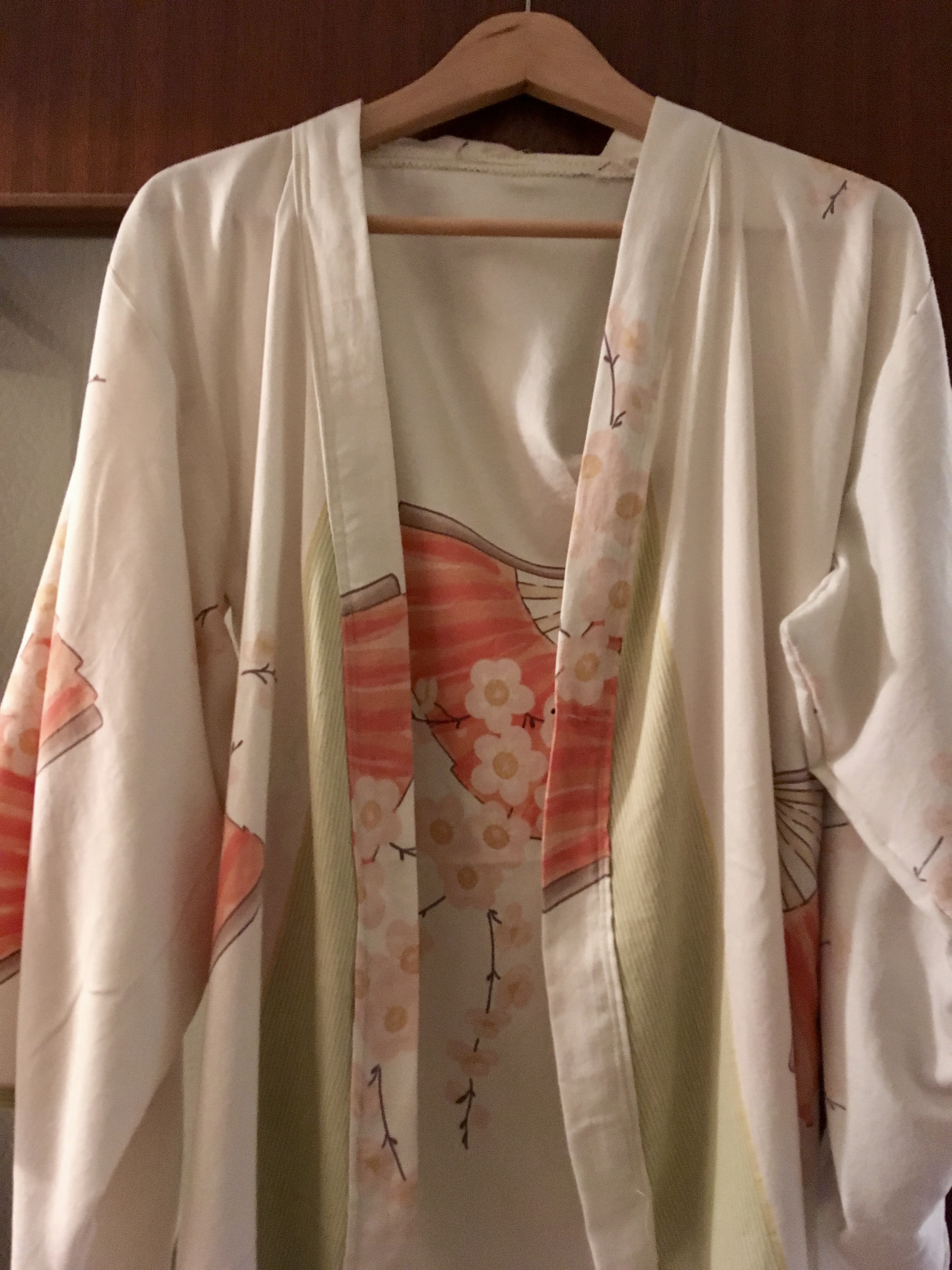
the ready product
Now, let's talk about the availability of fabrics.
I appreciate not having to weave fabrics on my own. There I can see the advantage of machines doing this work for me, for I would have no clue whatsoever how to process the raw materials. But still, I am backing away to buy new fabrics from the store. Why? There are tons and tons of used clothes out there. Out-dated clothes, thrown or given away ones.
Instead of inventing ever new technological ways to produce fabrics (mostly from harming or useless fibers nowadays), you can find used fabrics all over the places. But after decades of producing less quality fabrics out of synthetic and plastic fibers it gets more and more difficult to find fabrics out of naturally made fibers.
I wonder why that is. Because you see, as we are still mass producing crops and meat from plants and animals there must be also furs and skins and fibers to make fabrics out of them. Why people think to be more environmental conscious to switch to plastic fibers and think that this is more protective, I cannot really make sense of.
Isn't it already common knowledge that plastic does not rot in the same way as natural materials do? They dissolve in a short amount of time without harming while plastic - when observed under a microscope - reveals its long lasting particles which do rot ever so slowly and remain in everything we eventually digest. Have I missed something? For I still think that the human body and digestion-system cannot do well with plastic.
How much does one need?
In a former exchange of thoughts about the topic of Freedom and civilization with @vieira, he wrote:
Machines, since their implementation, have always had the consequence of generating oversupplies, which ends up producing overconsumption. That is because that is precisely its strong point, the quantity, after all the machines were created for mass production. At the time of the industrial revolution, when the first machines began to be used, the objects produced in factories by these machines were of poorer quality than the objects produced by, say, a craftsman, who spent more time on it and paid more attention to detail.
The only advantage that industrially produced objects had was that they were mass-produced, of lower quality but made in greater quantity, which made them cheap. If they were cheaper, they were more accessible to the population who could save money, or even buy more. These cheap objects ended up taking over the market and putting artisans out of work. In a short time, factories spread throughout Europe beginning the transition to capitalism, whose promise was to make everyone rich thanks to the production of trinkets.
Machines will make work easier with the goal of increasing production, but I am of the belief that if you want something genuinely of quality, you have to look for something that is not done in an automated way.
Earlier I said:
This should bring us to the question of how much of our own clothing we actually need over our lifetime, and the answer would be: as little as possible.
@vieira's reply:
I like to ask myself that question but in general, how many things that we have do we really need during our lifetime? I think we would be surprised to find out that the answer is, just like yours: very little.
People can have very simple lives and be happy, actually, we don't need too much, but I think most of the time we fall into a kind of illusion when we see the new objects, the new clothes, the new shoes, the new phone, and we end up buying a lot of things that we don't need, that don't make us happier, and that we'll eventually end up throwing away. It is a trap. And it is likely that this comfort-inclined lifestyle takes us precisely to the opposite place we want to go, leaving us, as I said in the post, less free, less independent, less happy, etc.
I agree with his statements and finish this post by the question:
How much would you like to become skilled yourself and what skill would that be?
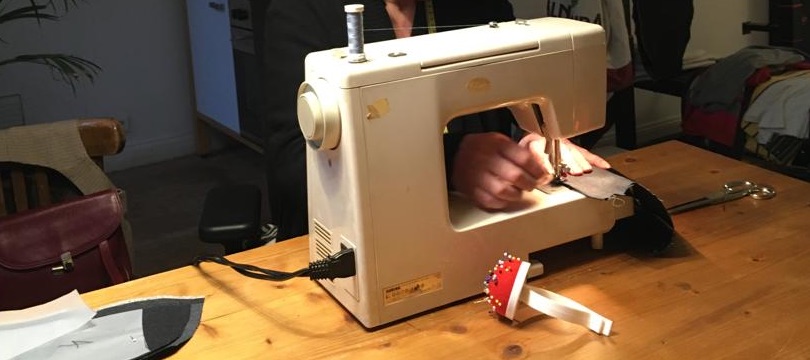
Beim Nähen mit einer Pfaff
Seit einiger Zeit befasse ich mich mit dem Nähen.
Ich übe mich im Zuschneiden von Stoffen, darin, die richtigen Proportionen für meine Körpergröße herauszufinden und viele Versuche und Irrtümer zu begehen. Was habe ich gelernt?
Dass die menschliche Hand, ein sehr komplexes und faszinierendes Gebilde ist. Eine Hand kann sehr viele Dinge tun, zu der eine Maschine nicht fähig ist. Es gibt wohl kaum etwas auf der Welt, dass der Geschicklichkeit von menschlichen Fingern gleichkommt, wenn man Material verarbeitet.

ein weiterer Kimono noch in der Mache - hier probiere ich ihn an
Nehmen wir eine Nähmaschine und vergleichen wir.
Eine Nähmaschine, bevor sie zusammengebaut und in der Lage ist, zu nähen, benötigt unzählige Teile. Sie hat eine Vielzahl von Schrauben, Federn, Zahnrädern, Gewinden, Kolben und so weiter.
Wenn man sich das Innere einer solchen Maschine anschaut, kommt man ins Staunen, wie viel Material, Metall und Kunststoff nötig ist, um nur eine einzige Funktion zu erhalten: Geradeaus zu nähen. Bis der Faden die nötige Spannung erreicht, die eine menschliche Hand durch bloßes einmaliges Ausprobieren bewerkstelligt, mussten viele erfinderische Stunden vergehen. Solches zu entwickeln, eine kreative und sicher sehr befriedigende Arbeit: Für den Entwickler.
Trotzdem: dafür, dass eine Hausnähmaschine nur in der Lage ist, geradeaus zu nähen, habe ich mich gefragt, ob es den Aufwand Wert ist, eine solche komplexe Maschine herzustellen, die nur ansatzweise in der Lage ist, menschliches Fingergeschickt zu kopieren, aber dennoch auf ihre maschinelle Funktion des Nähens reduziert bleibt.
Während die menschliche Hand, soweit sie mit Nähen fertig ist, zu weitaus mehr imstande ist.
Sie kann auch mit Messern, Töpfen, Pfannen umgehen, mit Bällen, mit Hämmern, Sägen, Beilen, mit Pfeilen und mit Bögen, mit Kämmen, Scheren, Bürsten, Hobeln, Schraubenziehern, Ösen, mit Gestellen und vielem mehr. Für alle diese wunderbaren Fähigkeiten unserer menschlichen Hände braucht es jeweils eine sehr aufwändig hergestellte Maschine, die immer nur eine bestimmte Sache kann.
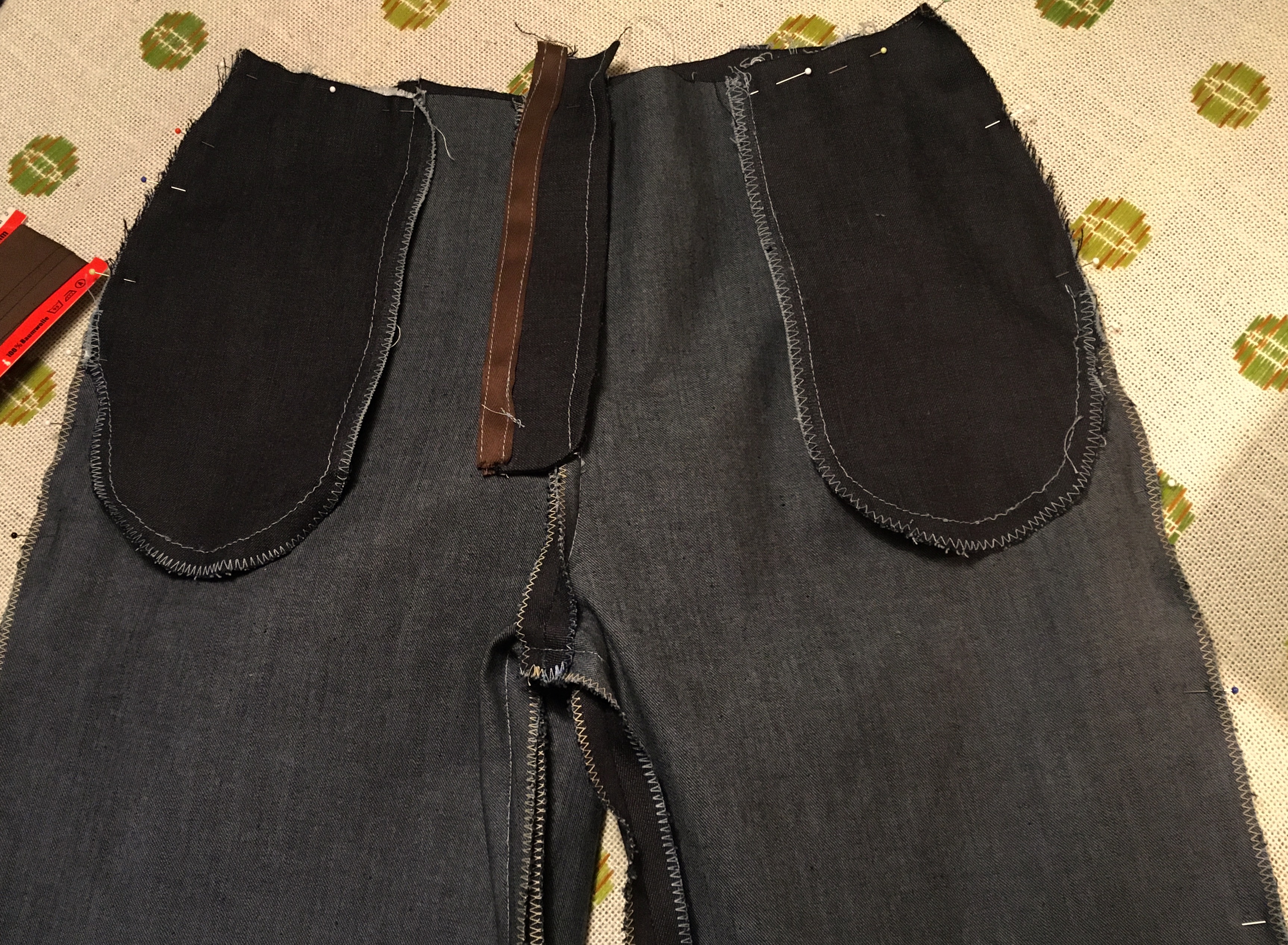
Eine Jeans-Hose im Bearbeitungsprozess - von innen betrachtet
Der so simpel anmutende Vorgang nur einer Bewegung der Hand, dem Auf- und Ab der Nadel, die von zwei Fingern gehalten und dann durch den Stoff gezogen wird, der von der zweiten Hand gehalten wird, benötigt auf der Maschinenseite einen immensen Aufwand an Technik und Apparatur.
Im Grunde lächerlich, soviel Metall und Material an erster Stelle zu beschaffen, zu formen, zu härten, zusammenzubauen, nur, um diese anmutige Arbeit kopieren zu können. So kann man sich an dieser Stelle die Frage stellen, wozu eigentlich?

Schnitte vorbereiten - hier ein gekauftes Schnittmuster - Schnitte selbst erstellen ist sehr aufwändig
Wenn es um Kleidung geht, dann ist die geringste aller Arbeiten die mit der Maschine am heimischen Tisch.
Es erfordert sehr viel mehr Zeit und Aufwand, den Stoff zuzuschneiden, ihn zum Nähen so vorzubereiten, dass er dann irgendwann, wenn die Mathematik vollbracht ist, zu einem passenden Kleidungsstück zusammenzufügen. Das Nähen von geraden Strecken ist im Grunde kaum der Rede Wert und zieht man den Grad an Beschäftigung und Aufwand ab, den es erfordert, überhaupt erst den Umgang mit der Maschine zu lernen, ist der Zeitgewinn eigentlich eher unrühmlich.
Im zweiten Schritt kann man sich nämlich fragen: Wozu will man eigentlich die Zeit für das Nähen gerader Strecken sparen, wenn der menschliche Körper nicht mehr als zwei Meter beträgt?
Zwei Meter Bahn per Hand zu nähen, ist überhaupt kein Problem. Tatsächlich stellt sich überhaupt erst ein gewisser Näh-Rythmus ein, wenn man längere Strecken zu nähen hat. Diese Strecke erst ist es, die einen gewissen Rythmus und eine Gleichförmigkeit erst ermöglicht.
Die Monotonie einer solchen Arbeit ist überaus beruhigend und meditativ. Sie bewirkt einen ruhigen Geist und eine ruhige Hand.
Wie viel Ärger im Vergleich habe ich mit meiner Maschine erlebt, wenn die Fadenspannung nicht korrekt ist, wenn die Faden und Stoff nicht zueinander passen und ich das nicht bemerke, weil nicht meine Finger den Stoff und sein Verhalten erfühlen, sondern die Maschine fehlerhafte Nähte produziert, wenn der Maschinennähfuß nicht kooperiert, wenn sich der Faden in Stoff und Maschine frisst, wenn ich an bestimmte Stellen gar nicht gut herankomme, wo es um Ecken, Rundungen und schwierige Kanten geht.
Wenn das Unten das Oben nicht sichtbar macht und ich dauernd den Nähfuß heben und senken muss, um zu kontrollieren, ob der Unterstoff nicht versehentlich mitgenäht wird. Und so weiter. Dazu die Mucken der Maschine selbst, die, wenn ich sie nicht korrekt handhabe, nicht gut arbeitet.
Mit der Zeit, ohne, dass man sich bewusst wird, passt man sich den Bedürfnissen der Maschine an und nicht etwa umgekehrt. Eine Maschine kann sich den menschlichen Bedürfnissen nicht in der von ihm benötigen Art anpassen, sie hat klare Limitierungen.
Kleidung für den eigenen Gebrauch zu nähen, ist sehr befriedigend. Sie mit der Hand zu nähen, ist sogar noch befriedigender.
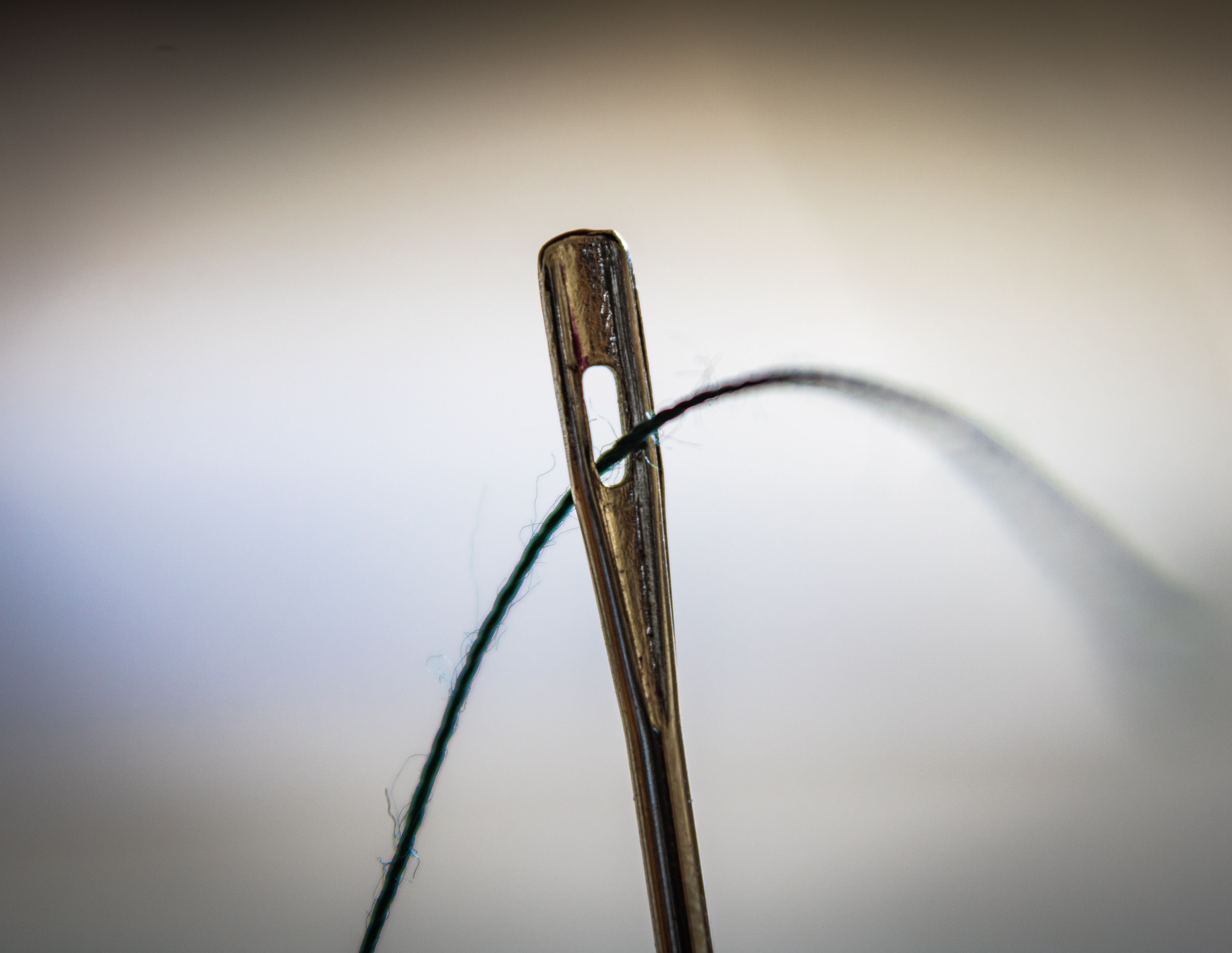
Photo by SUNBEAM PHOTOGRAPHY on Unsplash
Es ist keine Schande, eine Maschine zu benutzen, sicherlich nicht, aber man kann auch darauf verzichten. Der Verzicht führt zu bestimmten Erkenntnissen. Es mag etwas länger dauern, alles mit der Hand zu nähen, wenn man professioneller mit der Nähmaschine umgeht, aber für den eigenen Gebrauch ist es nicht wirklich notwendig.
Der Mythos, dass Nähmaschinennähte stärker sind oder besser halten, ist nur ein Mythos.
Handgenähte Nähte - wenn sie richtig gemacht werden - sind genauso stark und reißfest wie Maschinennähte. Aber der wahrscheinlich größte Vorteil ist, dass Sie den Stoff austricksen können. Eine Maschine kann nur den oberen und den unteren Stoff zusammennähen. Um das aber nicht zu tun und trotzdem eine zusammenhaltende Naht zu erzeugen, kann die menschliche Hand dazwischen nähen. Die Hand kann den Stoff in Winkel verdrehen, die eine Maschine nicht ausführen kann. Oder, wenn ja, speziell für diese eine Aktion hergestellt wird.
Worauf ich hinaus will, ist, wie viele verschiedene Maschinen braucht man, um die Handlungen auszuführen, die eine menschliche Hand allein dadurch ausführen kann, dass sie so ist, wie sie ist? Will sagen, die Tatsache, dass das Erlernen von Dingen, die man zuerst mit der Hand macht, eigentlich der Schritt für Entwickler ist, etwas zu schaffen, das diese Fähigkeit kopieren kann.
Es wird einen Moment geben, in dem du dich mit verschiedenen Maschinen für verschiedene Aufgaben langweilst, die alle deine Handarbeit ersetzen, und in dem du mit der Wartung von Maschinen beschäftigt bist, dir den Kopf über technische Fragen zerbrichst, Geld in den Austausch von Teilen investierst, mit anderen darüber redest, wie man sie wieder zum Laufen bringt und so weiter und so fort.
Es mag die Zeit wert sein, in sozialen menschlichen Kontakt zu kommen, aber es wird nicht dazu dienen, um unabhängiger von Maschinen zu werden.
Wenn erst einmal alles von Maschinen für dich erledigt wird, bleibt nichts mehr übrig, um wirklich kreativ und erfinderisch auf der eigenen Seite zu sein.
Wenn man verschiedene Arten von Maschinen für Nähzwecke im Haus hat, wie z.B. eine Geradstichmaschine, einen Overlocker, eine Stickmaschine usw., bleibt man ungeschickt, wenn es um echte Handarbeit geht.
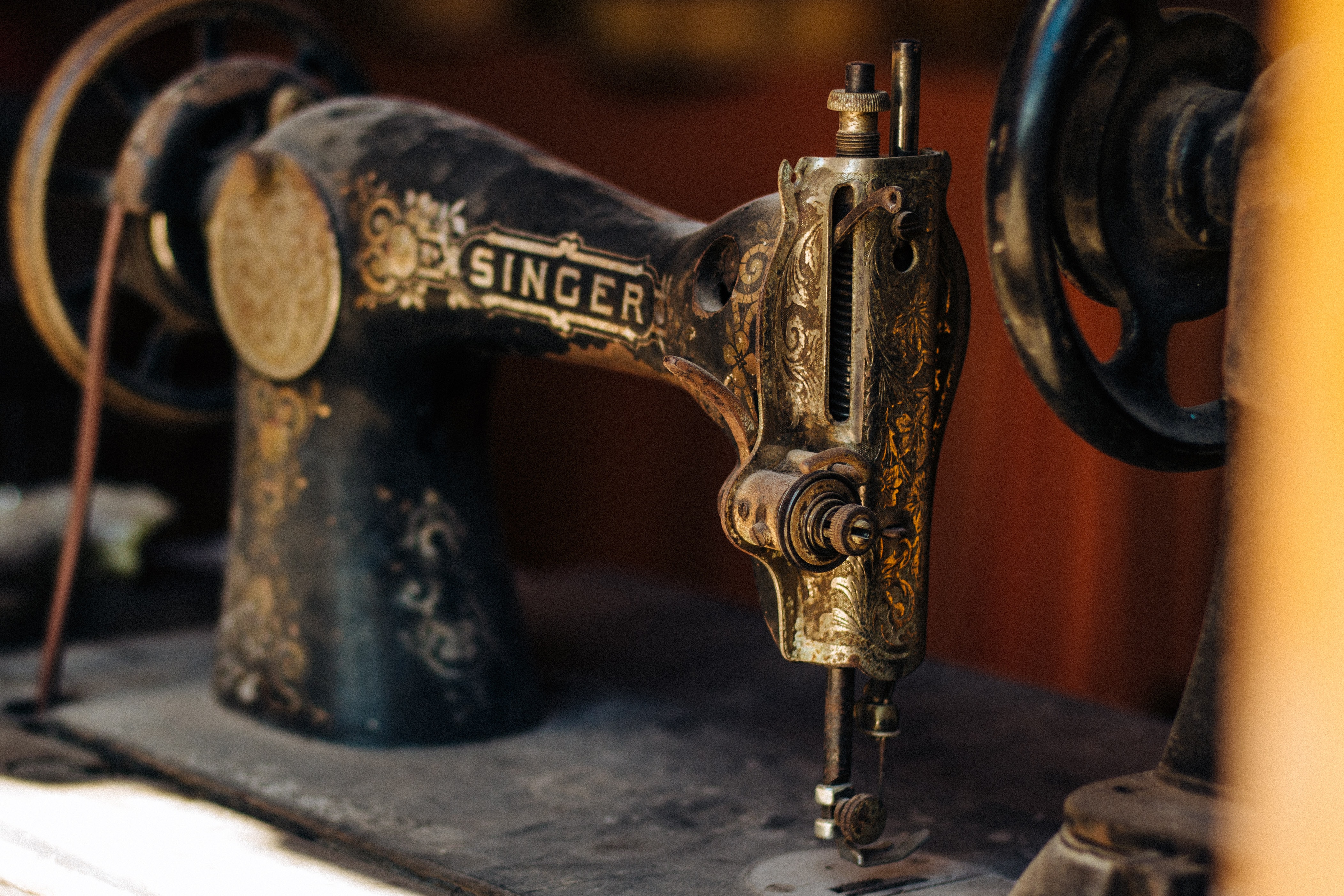
Photo by Adolfo Félix on Unsplash - Eine sehr alte Maschine. Es spricht nichts dagegen, sie zu reparieren und zu nutzen, wo sie schon noch da ist und Verwendung finden kann.
So wurde mir klar, dass der wirkliche Spaß am Nähen die Arbeiten sind, die eine gewisse Zeit dauern, meine Aufmerksamkeit und Konzentration benötigen, meine geschickte Spontaneität brauchen, um auftretende Probleme zu lösen, meine Kreativität herausgefordert werden soll und ich aus Fehlern lernen soll. Ich brauche eigentlich auch menschliche Lehrer, denn eine Maschine kann mir nichts beibringen.
Ich muss den Stoff fühlen und anfassen sowie die Verhaltensweisen der Werkzeuge, die ich benutze, kennen lernen. Wenn ich meine Hände zum Anfassen einsetze, merke ich viel schneller, wo es schwierig wird oder wo Schwachstellen zu beheben sind.
Reden wir über die Verfügbarkeit von Stoffen.
Ich schätze es, dass ich die Stoffe nicht selbst weben muss. Da sehe ich den Vorteil von Maschinen, die mir diese Arbeit abnehmen, denn ich hätte überhaupt keine Ahnung, wie ich die Rohmaterialien verarbeiten soll. Aber trotzdem schrecke ich davor zurück, neue Stoffe im Laden zu kaufen. Warum eigentlich? Es gibt tonnenweise gebrauchte Kleidung da draußen. Veraltete Kleidung, weggeworfene oder verschenkte.
Anstatt immer neue technologische Wege zu erfinden, um Stoffe zu produzieren (heutzutage meist aus schädlichen oder unbrauchbaren Fasern), findet man überall gebrauchte Stoffe. Aber nach Jahrzehnten der Produktion von minderwertigen Stoffen aus synthetischen und Plastikfasern wird es immer schwieriger, Stoffe aus natürlich hergestellten Fasern zu finden.
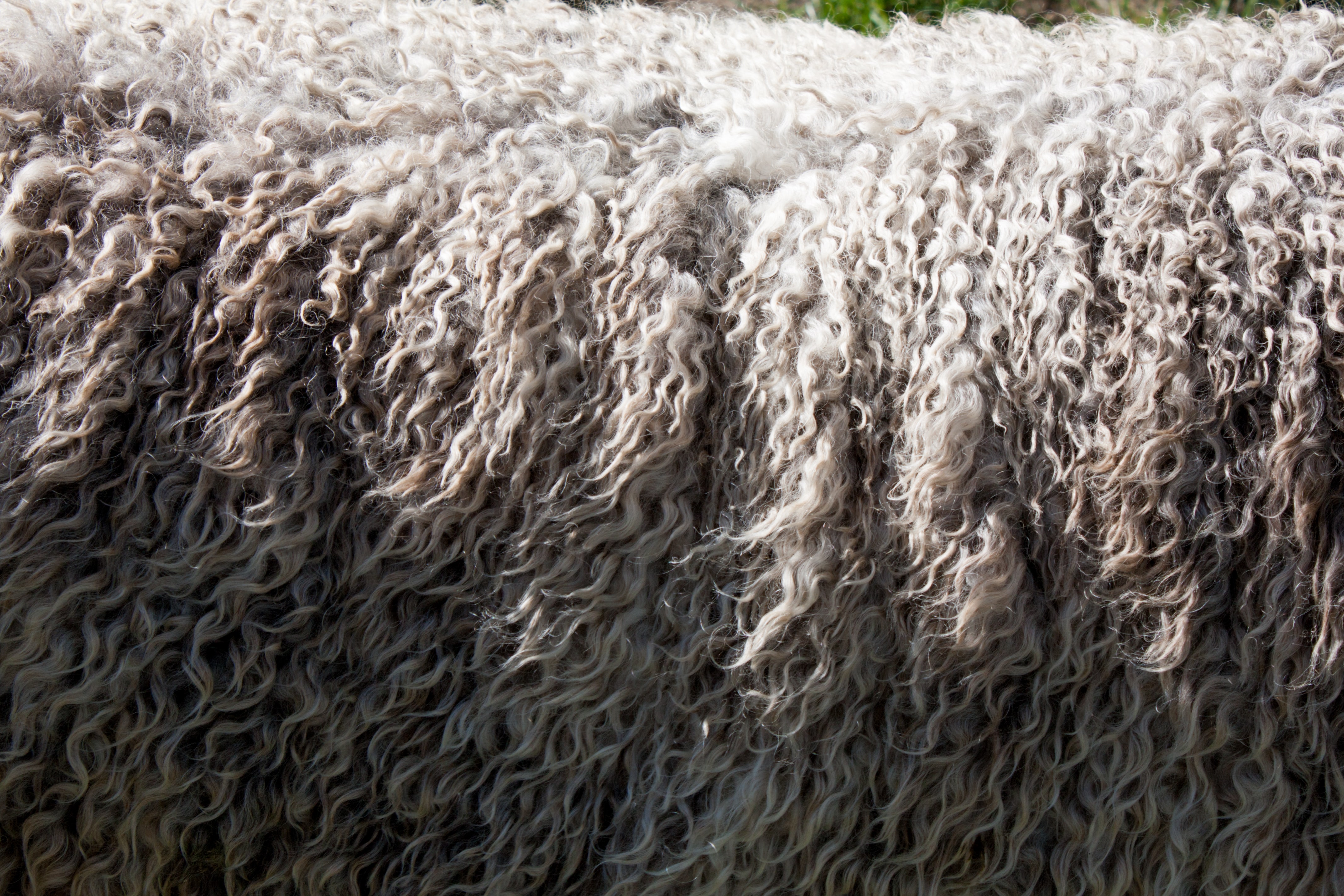
Photo by Vince Veras on Unsplash - Schafswolle
Ich frage mich, warum das so ist. Denn, da wir immer noch Getreide und Fleisch von Pflanzen und Tieren in Massen produzieren, muss es auch Felle und Häute und Fasern geben, um daraus Stoffe herzustellen. Warum die Leute meinen, umweltbewusster zu sein, wenn sie auf Plastikfasern umsteigen und meinen, dass dies schonender ist, kann ich nicht wirklich nachvollziehen.
Ist es nicht allgemein bekannt, dass Kunststoffe nicht so verrotten wie natürliche Materialien?
Sie lösen sich in kurzer Zeit auf, ohne zu schaden, während Plastik - wenn man es unter dem Mikroskop betrachtet - seine langlebigen Partikel offenbart, die sehr wohl langsam verrotten und in allem verbleiben, was wir schließlich verdauen. Habe ich etwas übersehen? Denn ich denke, dass der menschliche Körper und das Verdauungssystem mit Plastik nicht gut zurechtkommen.
Wie viel braucht man?
In einem kürzlich erfolgten Gedankenaustausch zum Thema Freiheit und Zivilisation mit @vieira schrieb er:
Maschinen haben seit ihrer Einführung immer die Konsequenz, dass sie ein Überangebot erzeugen, was am Ende zu einem Überkonsum führt. Das liegt daran, dass genau das ihre Stärke ist, die Quantität, schließlich wurden die Maschinen für die Massenproduktion geschaffen. Zur Zeit der industriellen Revolution, als die ersten Maschinen zum Einsatz kamen, waren die Gegenstände, die in den Fabriken von diesen Maschinen hergestellt wurden, von schlechterer Qualität als die Gegenstände, die z.B. von einem Handwerker hergestellt wurden, der mehr Zeit darauf verwendet hat und mehr auf Details geachtet hat.
Der einzige Vorteil, den industriell hergestellte Objekte hatten, war, dass sie in Massenproduktion hergestellt wurden, von geringerer Qualität, aber in größerer Menge, was sie billig machte. Wenn sie billiger waren, waren sie für die Bevölkerung leichter zugänglich, die Geld sparen oder sogar mehr kaufen konnte. Diese billigen Objekte eroberten schließlich den Markt und machten die Handwerker arbeitslos. In kurzer Zeit verbreiteten sich Fabriken in ganz Europa und leiteten den Übergang zum Kapitalismus ein, dessen Versprechen es war, jeden dank der Produktion von Schmuckstücken reich zu machen.
Maschinen erleichtern die Arbeit mit dem Ziel, die Produktion zu steigern, aber ich bin der Meinung, dass man, wenn man etwas wirklich Hochwertiges haben will, nach etwas suchen muss, das nicht automatisiert hergestellt wird.
Zuvor hatte ich gesagt:
Das sollte uns zu der Frage bringen, wie viel eigene Kleidung wir im Laufe unseres Lebens eigentlich brauchen, und die Antwort wäre: so wenig wie möglich.
@vieira's Antwort:
Diese Frage stelle ich mir auch gerne, aber ganz allgemein: Wie viele Dinge, die wir haben, brauchen wir wirklich während unseres Lebens? Ich denke, wir wären überrascht, wenn wir herausfinden würden, dass die Antwort, genau wie Ihre, lautet: sehr wenig.
Menschen können ein sehr einfaches Leben führen und glücklich sein, eigentlich brauchen wir nicht allzu viel, aber ich denke, meistens verfallen wir in eine Art Illusion, wenn wir die neuen Objekte sehen, die neuen Kleider, die neuen Schuhe, das neue Telefon, und wir kaufen am Ende eine Menge Dinge, die wir nicht brauchen, die uns nicht glücklicher machen und die wir am Ende wegwerfen. Es ist eine Falle. Und es ist wahrscheinlich, dass dieser komfortorientierte Lebensstil uns genau an den entgegengesetzten Ort bringt, an den wir gehen wollen, und uns, wie ich in dem Beitrag sagte, weniger frei, weniger unabhängig, weniger glücklich usw. macht.
Ich stimme mit seinen Aussagen überein und beende diesen Post mit der Frage:
This was quite an interesting read!
Two years ago my mother started teaching my daughter (age 10 now) and I how to sew. She tried teaching me when I was younger but unfortunately my ignorant attitude caused me to miss out because I thought it was boring and useless (at that time). But oh boy do I realize now what an opportunity I’ve missed out on. It’s more challenging learning how to sew now at an older age but it’s doable and I’ve remembered what she’s taught me so far.
I’ve known how to sew on a button and mend a hole by hand as long as I can remember and every time I’ve don’t that I felt so accomplished and independent.
The thing is we have become a microwave society where we want results fast and in the easiest way. Sewing by hand has many benefits like in the way you mentioned but it does take longer to get the results we crave.
I remember when my mother first start teaching me she wanted to make sure I was comfortable with straight sewing by hand before she put me on the machines. She first mastered sewing by hand and I really see how that benefited her.
This statement right here rings truth:
This reminds me of my dilemma of being afraid to create my own crochet patterns for the longest. I depended so much on using other people’s patterns instead of having the confidence to create my own that I was depending on finding patterns to fit my needs. When we use something for so long we end up solely depending on it and leave no room for our own growth and creativity.
I have definitely felt the frustrations of thread getting tangled and the machine not working. It would be interesting to be able to sew a project completely by hand. I get it, the whole experience of feeling the fabrics, weaving the needle through and seeing for yourself how to fix mistakes really would set a person up to be more self sufficient and observant. However, I know doing long works like this are very tedious for some and they’d rather stick with the machine. Everyone has their own preference and I think doing both ways we can learn a thing or two.
I do think having basic sewing skills like mending, adding a button/zipper is very important especially when a machine is not readily available.
Thank you for sharing such a thought provoking conversational piece with us! I see @muscara as already extended the invite to post with us from the NeedleWorkMonday Community ;) We’d love to see some of your handy work.
To find out more about what we do please visit our FAQs.
What a valuable answer, thank you very much for that.
I too have (had) a mother who introduced me to sewing, but she wasn't much of a seamstress herself and saw it more as a chore. But she had a green thumb and was wonderful with her plants and flowers in the garden and in the house.
How wonderful that your daughter is now learning to sew. She won't forget, it's like you say, the younger you are, the quicker you learn.
Haha, yes, microwave society is an apt term for the modern age.
That's a really good point you make here. Going beyond relying on prefabricated design, the most beautiful thing in craft is to have your own design ideas and be confident in implementing them. Only in this way do you grow beyond yourself and enjoy being able to create something of your own. It doesn't have to please everyone, the main thing is that you are happy with it yourself.
In fact, you don't have to be dogmatic about demonising something that others like to use for themselves. It is merely the realisation that one can gain for oneself how nice it is to make oneself completely independent of machines, when one has made the experience that it is also possible without. But I wouldn't want to force this on anyone, just open the space for further thoughts and the sharing of such experiences in a positive sense.
Thank you for visiting my blog and best wishes to you!
It was a pleasure reading and responding ;)
I am very delighted my daughter was not like me but instead wanted to actually learn :D
I’m so glad you opened up this discussion. It is really something for others to ponder on and consider.
Handnähen... das mag ich überhaupt nicht. Ich hatte mir für meine erste Nähmaschine sogar einen Fuß zum Knopf-Annähen gekauft ;)
Sachen, die man selber herstellt, haben nicht nur den Vorteil, dass sie genau die Art/Farbe/Form haben, die man möchte (wenn man es halbwegs hinbekommt) - man hat auch das Erfolgserlebnis. Das Gefühl, etwas eigenhändig Hergestelltes zu nutzen, ist wunderbar. Ob es nun Brot aus dem eigenen Ofen ist oder selbstgestrickte Socken.
Und man geht auch anders damit um. Ich würde nie gekaufte Socken stopfen - aber wenn ich die Tausende von Maschen selber gestrickt habe, dann wird die Lebenszeit ausgedehnt!
Falls du mehr Selbstgenähtes vorstellen willst - es gibt die NeedleworkMonday-Community ;)
Danke, die hatte ich ganz vergessen, die Needlework Truppe.
Ja, selbst machen ist was Gutes. Ich wünschte, ich könnte mehr als nur nähen und kochen, was das Handwerk angeht. Meine Eltern waren Selbstversorger, mehr als ihr halbes Leben lang.
Stricken kann ich zum Beispiel überhaupt nicht. Aber kann ja noch kommen :)
From the exchanges I have had with you, and also this publication, you have truly made me realize that sewing is both a simple and complex art.
I'd like to highlight this for a moment:
Absolutely true. I think that as the years go by we will realize that the machines we have created will end up making us regress to more weaker and dependent beings. Evolution, if the theory of evolution is right, is only the human response to adaptation. The conditions to which we are adapting don't favor us, it is only necessary to see what the screens do to our sight to realize it.
Recently I have had an interest in people who can guarantee their own food through cultivation, planting and harvesting. I don't really know much about it, but I find it wonderful to be able to provide yourself with all the food you eat, thing I'm not capable of. That's basically the only thing that catches my attention about agriculture. Maybe it would be good to be skilled at that, although land, space, readiness, etc. would also be needed, so for now it just seems interesting to me.
For the rest there are many things in which I would like to be skilled, but at the same time, none in specific.... A skilled writer maybe. :) But I guess you don't need to be skilled at something to enjoy it, and to do the best you can when you do it, so for now I'm content with that.
I'm glad you found what I said interesting, and thank you for bringing me to your pleasant post!
Edit: Very nice kimonos, by the way.
Yes, it's probably the most valuable of all qualities to be able to provide your own food. Permaculture has interested me for a long time, but it's like you say, you need land or at least a slightly bigger garden for that. My parents were self-sufficient for most of their lives, earning money only to provide themselves with basic existential resources such as salt, flour, sugar, etc. Many people who have lived exclusively "modern" lives recognise the value of self-sufficiency. There is a small trend of building mud houses or so-called Tiny houses and doing without modern comforts in parts of the western world, especially in the USA.
Sewing is just another consequence of my changing lifestyle since about 14 years ago. I have been slowly downsizing, but count myself in an insignificant minority, as not very many people are willing to do the same. I have always wondered whether I would ever share the fate of my parents and grandparents, or how long the prosperity we have enjoyed here could continue. But when some forebodings come true, they still hit hard. Spiritual poverty hits me harder than material poverty. I have become so accustomed to few luxuries that even a rich meal seems like something very precious to me. Just like the fact that I can heat. Or take a warm shower. You can do without a lot if there is a spiritual and cultural compensation, like celebrating festivals, singing or just being together and playing games. Without needing money for it. At the moment, it is difficult to create a festive atmosphere here. I hope not to become bitter about it. But it's always enough for a daily laugh.
Greetings and thanks for the compliment on the kimonos.
I think, you ARE already a skilled writer. ;-)
Irgendwann landen alle westlichen Intellektuellen (bzw. IAI nach N. Taleb) - wenigstens diejenigen unter ihnen, die den ganzen Unsinn, der ihr Hirn benebelt, überlebt haben, ohne zum Drogenabhängigen oder zum Anhänger einer modernen Religion zu werden - beim Handwerk oder wenigstens im Baumarkt.
Willkommen im Club!
Ich hoffe, du denkst nicht, dass ich intellektuell bin?
Danke für die Clubaufnahme :) bin zwischen vier Brüdern aufgewachsen, drei davon Schrauber. Da bleibt was hängen. Wie gehts deinem Auto?
Was ich meine, ist eh scheißegal. Danke, dem Alfa geht es beschissen, aber nächste Woche kommt er auf den OP-Tisch und dann macht Mario ihn wieder gesund, sprich: danach bin ich deutlich ärmer, aber die analoge Maschine rattert wieder.
Vladi steht auf Stricken übrigens. Ich glaub, ich mach da bald auch mal mit.
Dann drück ich dir die Daumen für den Alfa.
Wer ist Vladi? Ich kann mir dich beim besten Willen nicht strickend vorstellen :)
Vladi ist mein bester Kumpel. Ein sauberer Balkan-Macho. Er hat aber kein Problem, sich mit deutschen Omas in Strickrunden zu setzen und zu lernen.
Du hast ein Upvote von mir bekommen, diese soll die Deutsche Community unterstützen. Wenn du mich unterstützten möchtest, dann sende mir eine Delegation. Egal wie klein die Unterstützung ist, Du hilfst damit der Community. DANKE!
Toller Blog! Danke für den Mehrwert!
Liebe Grüße Michael
!invest_vote
!jeenger
Your contribution was curated manually by @mima2606
Keep up the good work!
Du bekommst ein
!BEER
von mir, ich weiss zwar nicht ob das hilfreich beim nähen ist, schmeckt aber!
View or trade
BEER.Hey @erh.germany, here is a little bit of
BEERfrom @siphon for you. Enjoy it!Learn how to earn FREE BEER each day by staking your
BEER.@mima2606 denkt du hast ein Vote durch @investinthefutur verdient!
@mima2606 thinks you have earned a vote of @investinthefutur !
Hello @erh.germany! Your post was selected by our staff on behalf of the OCD Community Incubation Program and has received an OCD upvote! Congratulations!!! Please keep sharing these quality posts :)
I invite you to share anything needlework related directly to the NeedleWorkMonday Community. On Monday’s we use the #needleworkmonday tag and on all other days the #needlework tag.
Written by @crosheille for the NeedleWorkMonday Community ~